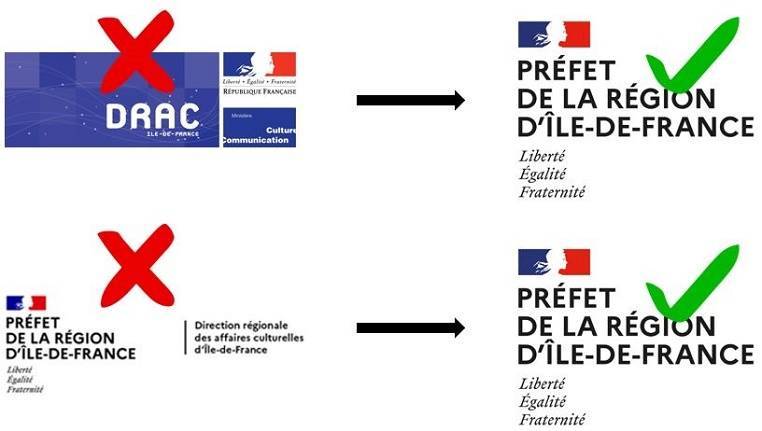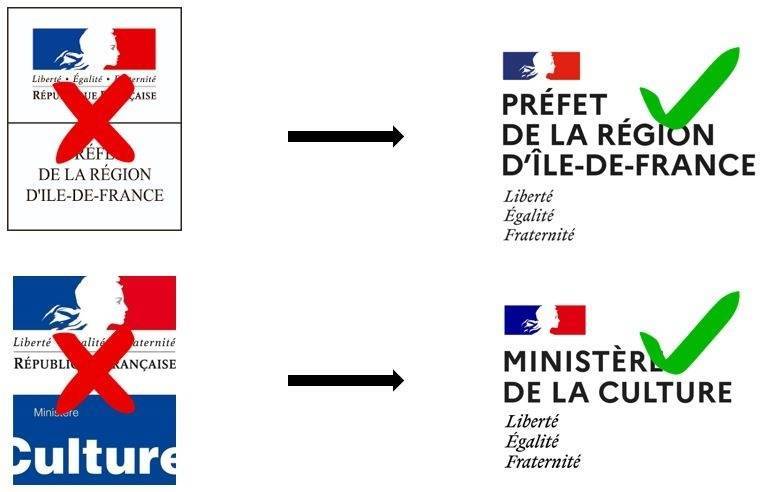Graphic charter and use of logos
The grants awarded by the DRAC Île-de-France require the recipients to affix the regional prefecture’s logo to all their communication materials. This article guides you through the conditions of use of the graphic charter of the State in the regions and presents the various scenarios.
Which logo for what use?
A decentralized department of the Ministry of Culture under the authority of the prefect of the Île-de-France region, the DRAC Île-de-France must be identified by the only trademark block of the regional prefecture (downloadable at the bottom of the page). When the support allows it, it is possible to attach the mention "Avec le soutien du ministère de la Culture – Direction régionale des affaires culturelles d'Île-de-France".
Please note: If you receive both the support of the DRAC and another state service under the authority of the regional prefect, it is this same block-mark that should be affixed to your supports.
Download the logo of the prefect of the Île-de-France region (CMJN format)
Télécharger le logo du préfet de la région d' Île-de-France (HD)
Télécharger le logodu préfet de la région d'Île-de-France (TIFF)
Si la subvention ou le parrainage provient d’une direction centrale du ministère de la Culture, c’est le logo du ministère qui s’applique, mais les modalités de communication varient. Reportez-vous à la page dédiée aux soutiens de l’administration centrale.
Quelle que soit la manifestation, c’est le logo du ministère de la Culture qu’il convient d’utiliser en y adossant, lorsqu’il existe, le kit de communication spécifique. Ces logos et leurs principes d’utilisation sont disponibles sur demande auprès du service communication de la DRAC :infocom.idf@culture.gouv.fr.
A noter : si, dans le cadre de cette manifestation nationale, vous recevez un soutien financier direct de la DRAC, vous pouvez ajouter la mention : " [Nom de la manifestation] est une manifestation initiée par le ministère de la Culture et mise en œuvre par la Direction régionale des affaires culturelles d’Île-de-France."
Les structures labellisées sur les secteurs de la création artistique obéissent aux règles énoncées plus haut : l’origine du soutien détermine le choix du logo (logo ministère en cas de subvention d’une administration centrale du ministère de la Culture, logo préfet de la région d’Île-de-France en cas de subvention de la DRAC).
Les labels patrimoniaux (Monument historique, Musée de France, Ville et Pays d’art et d’histoire, Maison des Illustres, Jardin remarquable, etc.) disposent d’un idéogramme ou logotype spécifique, disponible sur demande auprès du service communication de la DRAC, qui doit obligatoirement figurer immédiatement à droite du bloc-marque de l’État.
Comment utiliser le logo ?
Quel que soit le support et quel que soit le contexte de communication, le bloc-marque, composé de la Marianne en entrée et de la devise républicaine en fin, est unique et ne doit figurer qu’une seule fois sur un même support.
La dimension minimale du bloc-marque est en fonction de la hauteur de la Marianne, laquelle doit être au minimum de 2,5 mm ou 20 pixels.
Les blocs-marque vivent en priorité en couleur sur fond blanc. La défonce du bloc marque directement sur fond coloré est interdite. En cas d’environnement non maîtrisé, il convient de se conformer à la charte de l’État.
Qu’il soit imprimé ou digital, tout support sur lequel figure le bloc-marque doit impérativement être soumis pour validation au moins 10 jours avant envoi en impression et/ou mise en ligne au service communication de la DRAC.
Toute utilisation frauduleuse de la charte graphique de l’État est passible de sanctions pénales (3 ans d’emprisonnement et/ou 300 000 € d’amende)
Cas particulier : vous recevez le soutien de la DRAC et d’un autre service ministériel (ex : Intérieur, Éducation nationale, Jeunesse, Santé, Justice, Politique de la ville, Agriculture, etc.)
Dans ce cas, c’est le bloc-marque "Gouvernement" qui s’applique.
Si vous recevez à la fois le soutien de la DRAC et d’un autre service de l’État placé sous l’autorité du préfet de région, c’est le logo du préfet de région qu’il convient d’apposer sur vos supports. Dans le cadre d'un double soutien de la DRAC et du Rectorat, c'est également le logo du préfet de région qui s'applique, dans le respect de l'ordre protocolaire.
Les logos conformes et ceux qui ne le sont pas
Order of Logos
State brand blocks invariably occupy the first position at the bottom left on the logo bands. The other logotypes are positioned at the same level and in the same proportions.
In the case of multiple institutional partnerships, the following protocol must be observed: State – Regional Council – Departmental Council – Agglomeration Community or Community of Municipalities – Commune – other partners.
Special case: in the case of a European Union partnership, the EU logo takes precedence over all others and must therefore be placed to the left of the State mark.
Invitation cards
In the case of a nominative invitation, it is the regional prefect who, on behalf of the DRAC, is the inviting power. As the highest representative of the state, the prefect of the region is at the top of the list of inviting powers.
The invitation cards must be submitted for validation to the regional interdepartmental communication service (prefecture of Île-de-France region) via the DRAC Communications Departmentat least 10 days before sending to print and/or online.
Public speaking
According to Republican custom, at speech ceremonies, the state representative always speaks last. The sequences must be validated by the DRAC cabinet management.
For any questions or validation of the communication media: infocom.idf@culture.gouv.fr
Partager la page

